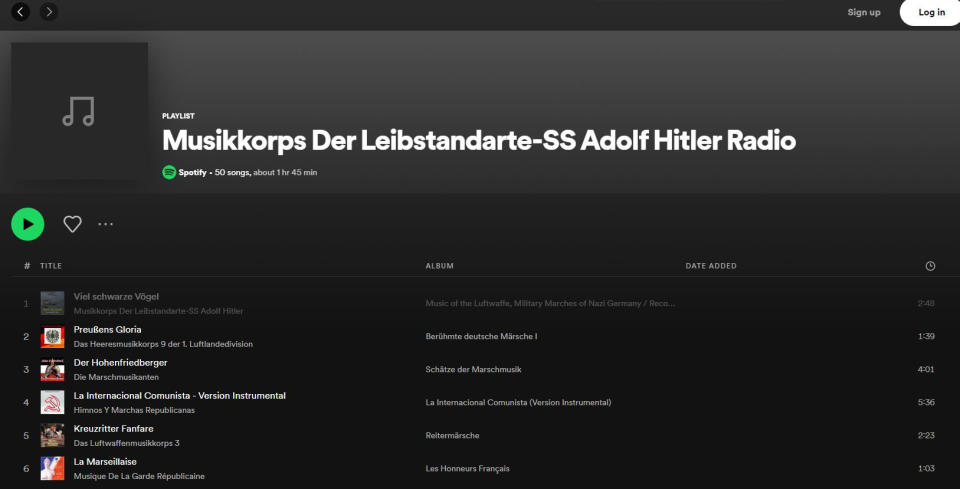Why Did Spotify Have an Official ‘Hitler Radio’ Playlist?

Until last week, any Spotify user could access a playlist titled “Musikkorps Der Leibstandarte — SS Adolf Hitler Radio” — so named for the Nazi fuhrer’s personal corps of bodyguards. The streaming service itself generated the track list, and multiple Rolling Stone staffers each received a different mix upon loading it. Depending on Spotify’s algorithm, the streaming service chose different — often benign — national anthems from throughout history, but two playlists featured music by Das Luftwaffenmusikkorps 3 (named after the Nazi air force).
One day after Rolling Stone’s inquiry to Spotify on why the service would offer, let alone generate, an “SS Adolf Hitler Radio” playlist — as well as why it was hosting a RaHoWa podcast (short for “Racial Holy War”) and several other instances of music espousing neo-fascist ideologies — the streaming service removed them.
More from Rolling Stone
F1 Live Stream: How to Watch the Formula One Racing Season Online
Jena Malone Says She Was Sexually Assaulted by 'Hunger Games' Coworker
'I Have No Reason to Make This Up!,' Marilyn Manson Accuser Tells Evan Rachel Wood in New Legal Doc
Spotify’s platform rules prohibit “content that incites violence or hatred towards a person or group of people based on race, religion, gender identity or expression, sex, ethnicity, nationality, sexual orientation, veteran status, age, disability or other characteristics associated with systemic discrimination or marginalization.” But despite these guidelines and past instances of the Southern Poverty Law Center (SPLC) and Anti-Defamation League (ADL) calling out the company and other streaming services for allowing “hate music,” musicians who support white power, antisemitism, and neo-fascist ideology continue to find homes on mainstream platforms.
Some groups, like the NSBM (National Socialist black metal) band Übermensch, attract more than 30,000 monthly listeners, while Burzum, a Norwegian NSBM trailblazer who recently whined on Twitter about getting flak for recommending Mein Kampf to readers, attracts 223,000 monthly listeners.
A three-month Rolling Stone investigation into the catalogs of Spotify, Apple Music, Tidal, and Amazon Music turned up a surprising number of purveyors of so-called hate music. Each service had musicians playing NSBM and “fashwave” (a proudly fascist form of electronic music), while some also offered Nazi hardcore punk, RAC (“Rock Against Communism,” a form of right-wing punk invented in reaction to the U.K.’s “rock against racism” concerts in the Seventies), and literal Nazi music from the 1930s and Forties.
Many of the musicians in question aren’t trying to conceal their politics: The most-played song on Spotify by fashwave musician IronMensch — previously highlighted in the ADL investigation — is titled “Aryan Fury”; his second most-popular track is “Reich Machine.” Some artists who violate Spotify’s terms of service have even been brought to the streaming service’s attention in the past. Even after an ADL investigation last September, music by IronMensch, fashwave musicians Elessar and OBNX and the NSBM group Übermensch continue to be available on Spotify.
“Music has long been used as a form of radicalization,” Calum Farley, an investigative researcher for the ADL’s Center on Extremism, tells Rolling Stone. “A platform like Spotify that has such a large reach makes it very easy for individuals to find the sort of music and be pulled into these spaces.”
“Innumerable acts of bias-motivated violence — from hate crimes to terror campaigns — have been committed and orchestrated in connection with the hate-music scene across dozens of countries,” Aaron Flanagan, deputy director of prevention and partnerships at SPLC’s Intelligence Project, tells Rolling Stone. “Such violence has been especially concentrated where hate music intersects the racist skinhead scene.
“Hate music has also been a way for millions of dollars to flow into the global white-supremacist movement and related movements and music scenes,” he continues. “Sometimes this money has flowed directly into the hands of terrorist organizations and networks. It is impossible for those producing and writing hate music to achieve the kind of simple, easy, and relatively cost-free visibility [without] online streaming services. It is imperative that these platforms be accountable to enforcing their terms and conditions and removing such hateful propaganda: Doing so can literally help stem the tide of exposure to hateful, terroristic material.”
Rolling Stone’s investigation across the streaming services turned up albums and tracks by groups identified online as fashwave (Elessar, OBNX, Xurious), national socialist hardcore (Still Burnin’ Youth, removed from Spotify and Apple Music after Rolling Stone identified them), and NSBM (Infernum), among others. On Apple Music, searching “fashwave” turned up eight user-generated playlists and “NSBM” garnered six; the search terms “fashwave” delivered 38 user playlists on Spotify, and “NSBM” was featured in the titles of 20. Tidal had the least amount of neo-fascist groups that could violate its terms of service.

Each of the streaming services has language prohibiting hate speech similar to Spotify’s. (See Apple Music‘s, Tidal‘s, and Amazon Music‘s terms of service.) So how do these musicians get around the supposed rules? The full answer remains blurry.
“Over the past year alone, Spotify has taken action on tens of thousands of podcast episodes, playlists, and hundreds of tracks for violating our Platform Rules, which prohibit content that incites violence or hatred towards a person or group of people,” a Spotify spokesperson tells Rolling Stone. “Spotify has made — and will continue to make — significant investments in both human and algorithmic detection measures to help ensure our platform provides a safe experience for all and we remain committed to rigorously enforcing these platform rules. In this instance, Spotify reviewed the content in question and removed that which was found to be in violation of our policies.”
Reps for Tidal and Apple Music returned Rolling Stone’s requests for comment by asking which music violated their terms of service, though they did not provide any statements or make anyone available for an interview. Amazon Music did not return Rolling Stone’s requests for comment. (As of publication, Apple Music removed some of the music Rolling Stone identified, while it’s still available on Tidal and Amazon Music.)
“Action must be taken to proactively identify harmful content as soon as it appears on their platforms, in addition to reactively responding to takedown requests from users and experts,” Megan Squire, deputy director of data analytics and open source intelligence at SPLC’s Intelligence Project, says. “As the hate-music scene has evolved since the early 1980s, some bands and labels have become adept at evading hate speech and ethnic discrimination laws passed in countries like England, Canada, Germany, and elsewhere. Bands who are willing to disguise their beliefs through softened lyrics still remain connected to violent and hateful movements and ideologies.”
Although racism has been pervasive in popular music for decades — one of the first known recordings of an African American bears a slur in its title — the idea of “hate music” took root in the Sixties on racist country songs attributed to “Johnny Rebel,” whose recordings are still available on CDs via neo-Nazi websites. The Rock Against Communism movement, which staged white-power concerts across the U.K., took hold in the late Seventies, attracting skinhead fans to bands like Skrewdriver and Skullhead. One Skrewdriver song, “When the Boat Comes in (N—-r N—-r),” goes, “We won’t stand and watch our land be taken without a fight/N—-r n—-r out out!” (The song is still indexed on Spotify but unplayable.)
In the Nineties, the rhetoric of white power made its way into the work of some extreme heavy-metal musicians, especially in Norway, where one of the most popular, Burzum’s Varg Vikernes, extolled Nazism while serving time for murder. The most recent iteration of hate music in the past few years has been “fashwave” (there’s also a “Trumpwave”). Its musicians’ messages are far less overt than their forerunners and are often buried under EDM beats. Although discussed mostly on internet message boards, fashwave musicians have found an easy home on streaming services.
“Streaming services continue to fail with content created by those who make efforts to soften or code their lyrical content or album art, and those who do not perform or print their lyrics in English, if they share them at all,” the SPLC’s Flanagan says.
“Fashwave was a good example of showing how [neo-fascist music] is growing in that these purveyors will take a genre or a type of music that’s [already] popular, and then try to co-opt it into their movement,” the ADL’s Farley says. “Fashwave started off with vaporwave and other forms of ambient electronic music that then got co-opted into extremist spaces.” Farley adds that he’s seen new music, similar to “fashwave,” that is now imbuing hateful messages into a subgenre called “phonk.”
“White supremacists are continually attempting to innovate and rejuvenate hate music, as interest wanes in particular genres over time and younger generations with new, different interests in media and music come of age,” Flanagan adds. “Today, racist skinheads play a smaller role than ever, with the largest shows internationally connected to extreme metal genres promoting white supremacy, fascism and neo-Nazism.”
Organizations like the SPLC and ADL have called on streaming services many times over the past decade to enforce their terms of service, but the companies seem to be falling short of expectations. Since 2014, Rolling Stone has published three different articles about streaming services removing hate music, yet the issue persists. Since none of the streaming services would make staffers available for interview, it’s impossible to tell how they define which musicians satisfy their terms of service. That said, there are many resources available online that explain how to identify neo-fascist symbolism in music. (Rolling Stone contributor Kim Kelly has written two, one for the Columbia Journalism Review and one for Gizmodo.)
Farley questions the vetting process for musicians submitting their work to streaming services, and wonders how some “hate music” purveyors have become “verified artists” on Spotify. “Why isn’t there some screening process beforehand so they don’t get on the platform in the first place?” he asks.
The SPLC also offers several resources for identifying hateful messages in art, and is planning on expanding what it offers. “In addition to our regular monitoring using digital and analog methods, the SPLC is currently testing a variety of proactive content removal methods,” the SPLC’s Squire says. “One such product is a tool that helps us actively seek out hateful audio and video content on websites and social media platforms, allowing us to request takedowns by the host site.
“However, it should not be solely up to watchdog organizations to police content and ask for its removal after it has already done damage,” she continues. “This software is just one of a number of similar products and is broadly available.”
Ultimately, both the ADL and the SPLC reps hope that the streaming services uphold their content guidelines and work harder to spot hateful content. “The issue is private businesses enabling hate and bigoted extremist content, which has an undeniable impact on people’s everyday lives,” Squire says. “When businesses provide a platform for — and profit from — harmful content, they then bear the responsibility for promoting hate-fueled violence.”
Best of Rolling Stone

